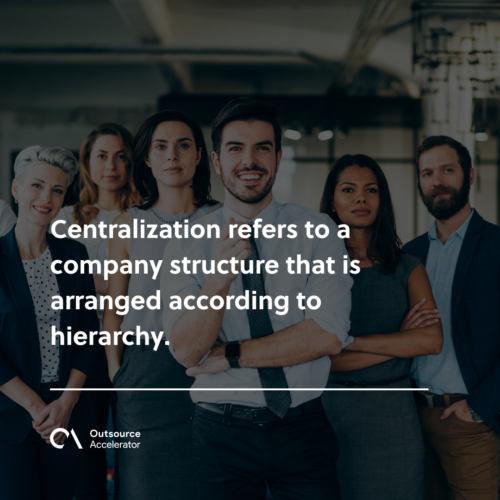Centralization vs. Decentralization: Which is the best fit for your company?

When running a company, giving the most authority to the highest-ranking employees or a board of directors makes sense.
They have the proper knowledge, skills, and experience to advance their ranks and are qualified to make major business decisions.
An organization that uses this format is centralized.
However, there’s another option for an organization’s structure, and that is – decentralization.
In this model, authority is spread throughout different units, and lower-ranking employees have a say in decision-making.
Before running a business, you must consider centralization vs. decentralization.
In this article, discover the significant factors of centralization vs. decentralization, including their definitions, key differences, advantages, and disadvantages.
Evaluate these two concepts and decide which will benefit your company most without compromising your plans, goals, and values.
Centralization vs. Decentralization defined
Businesses often decide whether to adopt a centralized or decentralized structure. Both approaches have their own set of characteristics and implications.
Understanding the differences between centralization vs. decentralization is crucial for determining which structure suits your firm.
What is centralization in business?
Centralization refers to a company structure that is arranged according to hierarchy.
In this model, authority in decision-making is placed on a central governing body or a few top-level individuals of an organization. This implies that the autonomy given to lower-ranked employees and branches is limited.
Additionally, the flow of information and power follows a top-down approach.

What is a decentralized structure?
Contrary to centralization, decentralization involves the distribution of decision-making authority across different levels or units within a company.
In a decentralized structure, decision-making power is shared among various departments, teams, or individuals. This approach promotes greater autonomy, responsibility, and flexibility at the lower levels of the organization.
Those are the basic definitions of centralization vs. decentralization. Let’s delve deeper into these concepts by discussing their key differences.
Centralization vs. Decentralization: Key differences
Besides decision-making authority, centralization vs. decentralization have significant differences.
Here are some of them:
Responsibility
In a centralized structure, the overall burden lies on a small group of executives. They administer the firm’s vision without much input.
In a decentralized organization, managers and employees share responsibilities. This promotes feedback and opinions from workers.
Ideal company size
Centralization makes more sense to implement in small businesses.
There aren’t many employees, so putting the duty of decision-making on a few individuals would be a better fit.
Meanwhile, decentralization is ideal for large firms. Spreading responsibility across a large number of workers will help speed up the information flow.
Communication and flow of information
A centralized structure often involves a strict chain of command. This can lead to slower communication and flow of information.
Additionally, centralized businesses usually restrict employees’ interaction with customers. This is done in an effort to protect the company’s image.
Decentralization promotes open communication. It enables collaboration and knowledge sharing across different areas of an organization and enhances customer relationships.
Ideal nature of work
Centralization is a better fit for work that requires lower effort and skill since it will be easier to monitor effectively. On the other hand, highly-specialized roles and responsibilities demand greater attention. This nature of work calls for a decentralized structure.
Chain of command
The definitive chain of command in a centralized system guarantees that workers will receive clear instructions. This can provide guidance to employees who seek it.
In contrast, a decentralized structure is more ambiguous. This may result in confusion regarding expected workflows.
However, the increased autonomy that comes with decentralization is more beneficial to employees who prefer flexible schedules.
Responsiveness to employee needs
A centralized system tends to prioritize the bigger picture: The overall goals and strategies of the organization. This may cause an oversight regarding the needs of individual departments, including company resources.
In comparison, decentralization enables a more effective response to the needs in question. Since it offers more autonomy, it consequently allows various departments to allocate and use the resources they require.
Centralization vs. Decentralization: Benefits and drawbacks
Each structure has its own set of benefits and drawbacks. These need to be considered before choosing which structure to implement.
Let’s first discuss those factors of centralization:
Advantages of centralization
Centralization provides the following benefits:
- Streamlined decision-making. Centralization allows for faster decision-making because fewer individuals are involved in the process.
- Coordination. With centralization, there is greater control and coordination of resources and activities.
- Consistency. A centralized structure guarantees that the policies implemented throughout the company are uniform.
Drawbacks of a centralized structure
While centralization offers various pros, it’s always best to know its downsides:
- Lower employee satisfaction. A centralized structure may lead to lower motivation and empowerment of workers. In addition, it will also result in less creativity and diversity in ideas and a higher likelihood of resistance.
- Reduced flexibility. Centralization can limit the ability for a quick response to the shifting market and the needs of customers. On a related note, here’s an article on six recession-proof strategies for the survival of your business.
- Overburdened employees. Centralization burdens top employees heavily because they are responsible for making all major decisions.
Now, let’s look at the advantages and disadvantages of a decentralized organization.
Advantages of decentralization
Like centralization, decentralization also has its set of benefits:
- Employee empowerment. This is one of the most significant benefits of a decentralized structure. Employees are empowered, motivated, and provided with a sense of ownership and accountability for their work.
- Innovation and diversity. More employees can give their input in a decentralized structure, which enhances innovation, creativity, and diversity in ideas.

Disadvantages of decentralization
Although decentralization provides formidable advantages, it also has the following cons:
- Inconsistency. In a decentralized structure, there is a high risk of inconsistency in implementing policies and procedures.
- Clashing opinions. Spreading decision-making throughout an organization involves more people, which leads to a higher chance of differing perspectives. Getting everyone on the same page and agreeing on something may be a challenge.
- Increased costs: Maintaining a decentralized structure may result in duplicated resources and inefficiencies. In this case, there will be an increase in expenses.
Having learned the benefits and drawbacks of centralization vs. decentralization, it’s a good time to ponder which is the better option for your business.
Centralization vs. Decentralization: Which is the best fit for your company?
Centralization vs. decentralization both have their own merits and trade-offs, as you’ve seen in the previous sections. To make an informed decision, establish what is important to you and what aligns with your vision and values.
Consider the following before deciding:
- Do you value innovation and creativity over uniformity and consistency?
- Do you like the idea of increased autonomy for lower-ranked workers?
- Does placing decision-making on a small group of top employees help make your vision come to life?
Considering these and all other factors discussed in this article, you can determine whether a centralized or decentralized structure best fits your organization.







 Independent
Independent




